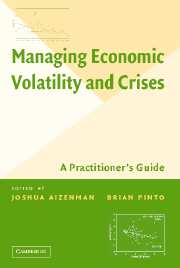Book contents
- Frontmatter
- Contents
- Contributors
- Acknowledgments
- Foreword
- MANAGING ECONOMIC VOLATILITY AND CRISES
- Overview
- PART I WHAT IS VOLATILITY AND WHY DOES IT MATTER?
- PART II COMMODITY PRICES AND VOLATILITY
- PART III FINANCE AND VOLATILITY
- PART IV MANAGING CRISES
- 8 Managing Macroeconomic Crises: Policy Lessons
- 9 Lessons from the Russian Crisis of 1998 and Recovery
- 10 Argentina's Macroeconomic Collapse: Causes and Lessons
- 11 Default Episodes in the 1980s and 1990s: What Have We Learned?
- Technical Appendix
- Index
- References
11 - Default Episodes in the 1980s and 1990s: What Have We Learned?
Published online by Cambridge University Press: 25 July 2009
- Frontmatter
- Contents
- Contributors
- Acknowledgments
- Foreword
- MANAGING ECONOMIC VOLATILITY AND CRISES
- Overview
- PART I WHAT IS VOLATILITY AND WHY DOES IT MATTER?
- PART II COMMODITY PRICES AND VOLATILITY
- PART III FINANCE AND VOLATILITY
- PART IV MANAGING CRISES
- 8 Managing Macroeconomic Crises: Policy Lessons
- 9 Lessons from the Russian Crisis of 1998 and Recovery
- 10 Argentina's Macroeconomic Collapse: Causes and Lessons
- 11 Default Episodes in the 1980s and 1990s: What Have We Learned?
- Technical Appendix
- Index
- References
Summary
ABSTRACT: This chapter reviews the approaches to resolving sovereign defaults on external debt to private creditors in the 1980s and 1990s. Approaches to dealing with debt crises have changed quite radically during this period; the formal mechanisms of the 1980s that were designed to facilitate cooperation among debtors and creditors have given way to the more recent market-based debt workouts. The focus is on assessing the effectiveness of the various approaches to dealing with market inefficiencies, and offering some lessons for debt workout mechanisms for the future.
DEBT CRISES CAN BE COSTLY
External financing can help a country grow faster by financing productive investment and by minimizing the impact of shocks on economic activity. Excessive debt flows, however, can be a problem for emerging market countries. As debt burden rises, a country becomes more vulnerable to stoppages or reversals of such flows and to debt crises. Historical evidence from the 19th and 20th centuries suggests that cross-border lending to sovereigns has generally been characterized by cycles of boom and bust, and associated debt crises. Historically, foreign lending has been characterized by recurrent debt crises: in the 1820s, 1870s, 1890s, 1930s, and 1980s (Lindert and Morton 1989). These debt crisis episodes usually followed a wave of international lending, such as the British lending spurt of the 1850s and 1860s to finance railroads in Latin America, the wave of European financing to Argentina in the 1880s, the U.S.-led bond financing boom of the late 1920s, and the bank lending spurt of the 1970s that recycled petro-dollars from the first oil price shock of 1973 to developing countries.
- Type
- Chapter
- Information
- Managing Economic Volatility and CrisesA Practitioner's Guide, pp. 471 - 520Publisher: Cambridge University PressPrint publication year: 2005
References
- 3
- Cited by



